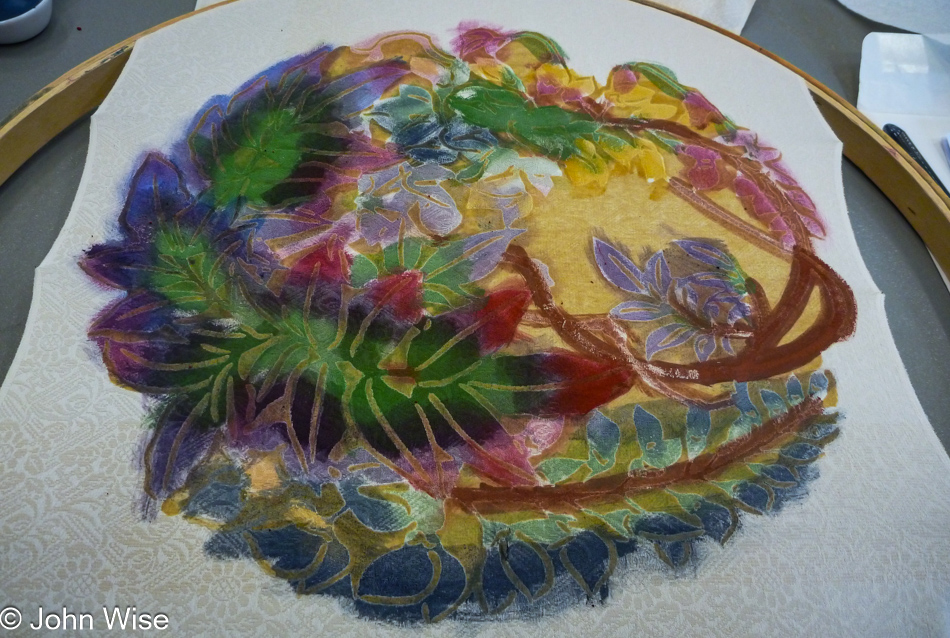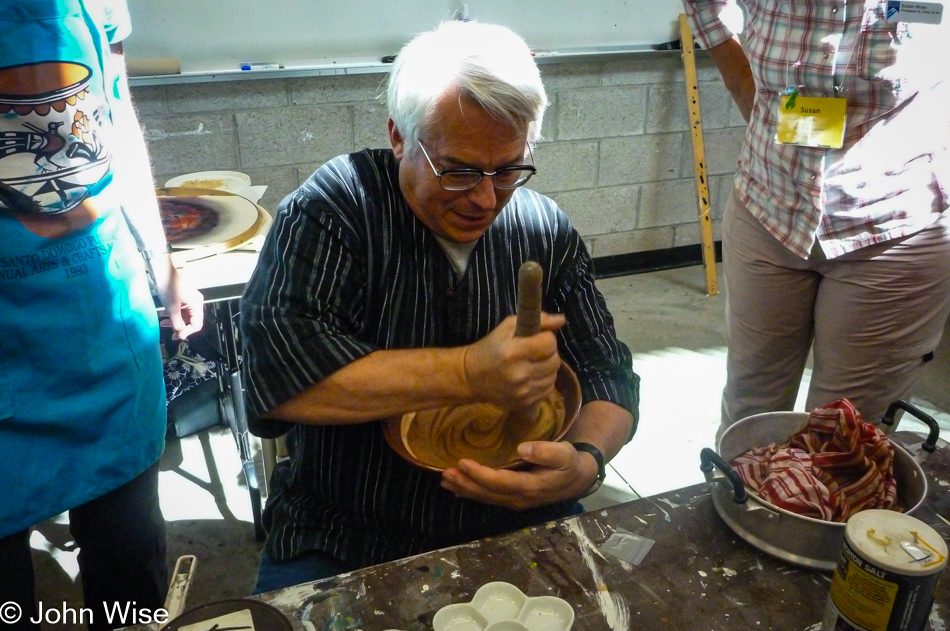
Caroline will be busy all day with her workshop, leaving me to do the proverbial “whatever.” Whatever for me is to go out and laze about in the verdure. I couldn’t ask for better weather, bluer skies, or more dramatic scenery. I love the San Juan Mountain range. There is something about these mountains that speaks to me more than almost any other I have traveled through and over here in the lower 48 states. The San Juans feel more accessible and more intimate compared to, say, the sub-range of the Rocky Mountains that make up Glacier National Park. Don’t get me wrong, Glacier is beautiful, but there seems to be more to be seen here in the San Juans for the casual passerby who may not have the time to really get out and explore the mountains.

Those tiny specks down in the valley make up the old mining town of Silverton, Colorado. It was a mere 48 miles (77km) from Durango up to Silverton, and still, I required more than 2 1/2 hours to make my way this far. There are meadows along the way that beg those susceptible to such messaging to stop, get out of the car, and check out the lilypads covering the surface of small ponds or the wildflowers punctuating the landscape. There are two other popular methods that allow one to travel slower from Durango to Silverton; the first is the Durango & Silverton Narrow Gauge Railroad – it takes 3 1/2 hours to chug up the hill. The other method is to use a bicycle. I have no idea how long that takes, but passing some of them while I was doing only 20mph, my guess is they were lucky to be making a mile an hour up some of the steep mountain grades.

Not really knowing where I would ultimately end up, I was just following the road. At a fork where to the left I would be on my way to Ouray, I veered right to visit Silverton. At the end of town, I noticed that the road kept on going. Caroline and I had never ventured this far northeast of the downtown area. Quickly, the road loses the pavement and becomes a very well-maintained dirt road. To the left of the road is the Animas River; melting snowfields and waterfalls running out of the mountains bordering this trail are feeding the river – I need to take note to return and spend some days camping out here.

And now you know why this old dirt road is out here: I am in mining country. As far as I can tell, there is no more mining out here, and certainly not at this wreckage of a former mining site. Off the beaten path, away from the popular National Historic District of Silverton, which is already far removed from America’s big cities, it’s a difficult picture to draw in one’s mind how busy these trails were 140 years ago as men became rich hauling ore out of these mountains. Towns would spring up for a few moments, becoming home to thousands before they would disappear back into the scenery with few remnants to remind us of a way of life long gone.

Eureka, I found it. I didn’t actually find anything much, but I did arrive in the ghost town of Eureka – and the end of the road for me. A steep, narrow road is only recommended for those with 4-wheel drives or all-terrain vehicles that continue out of town. That road heads up to Animas Forks, another old mining ghost town, but one with a claim to fame. Animas Forks features the ruins of a three-story home once owned by Thomas Walsh, who bought and gifted the famous Hope Diamond to his daughter for a wedding present. It’s but a short drive up that trail at only 4.6 miles, but I play it safe, not wanting to push my little Kia too far.

Back on the pavement, I shift speed, going from 5mph to the blazing 20mph I was traveling before my Silverton detour. Caroline won’t be finished before 5:00 p.m., so I have time to lounge about. This corner in the road looks as good as any to stop for a moment to enjoy the landscape. Somebody will make millions someday when they figure out that roadside hammocks for rent would be a goldmine in places like this.

If you don’t pay attention when traveling north, you just might miss this. This is a cascade flowing out of the mountains next to a small, rough road. The water flows right through a natural hole bored into rock and emerges 40 feet away from its cave. The highway department went ahead and built the road right over the rock bridge. The pullout is often very busy with travelers moving south, vying to get a good shot of the cascade from the road as they approach this bend in the road. As I stood there trying to get a photo, some stranger walking by told me how his friend found a gold nugget here last year. Not too far a stretch, really, as this area had some of America’s richest gold mines at one time.

End of the road for my day trip – Ouray, Colorado. It took me 6 hours to travel 67 miles (108km), and you thought I was joking about my speed. Caroline and I have meant to return to Ouray for many a year. Down in that village, you are in one of the most idyllic hamlets in America. If I had one complaint, it would actually be two complaints: no McDonald’s and no Starbucks. Perfection is just a latte and a set of golden arches away. Just kidding, seriously. Do you think the guy who will eat Burmese pig ear salad and loves kimchee needs Mickey D’s? The coffee, on the other hand…

The drive back to Durango took less than two hours. Caroline’s class was winding down. She is taking a class with John Marshall, a noted textile artist from California, to learn about Katazome, a Japanese textile dyeing technique that involves applying rice resist paste to a piece of fabric with stencils. Once the paste has dried, pigments or dyes can be painted onto the fabric.

Here is John Marshall preparing more rice-resist paste in a Japanese mortar and pestle bowl.

Dinner tonight was eaten in the college cafeteria (the Intermountain Weavers Conference took place in Fort Lewis College, Durango). No wonder college students from the Midwest have such boring tastes when it comes to diet. We were sticking around to listen to a keynote address in the hottest auditorium I have ever sweat in (the building had no air conditioning and huge fans were brought in because of the heat wave we are currently experiencing). The speaker was noted Shibori expert and educator Yoshiko Iwamoto Wada. Her talk was fascinating as she walked us through the foremost icons in Japanese fiber design working today and the ancient techniques they are trying to keep alive in these days of mass production. Afterward, we had a little more time to dive into the art exhibits hosted by the conference. The basket sculpture in the photo above was created by our friend Sharie Monsam of the Telarana Fiber Arts Guild.

Vegetarian trophy heads. I didn’t see this one coming. For those who enjoy a little stuffed head taxidermy of a trophy kill but would like to be animal cruelty-free while admiring the beast mounted on the wall, try knitting your own. That’s just what this young 22-year-old woman, Syndi Roberts, did. I wonder if I found a dead bear someday out on the trail that died of natural causes, and I shorn that old bear to bring the fiber home to Caroline. Could she spin my bear fur into yarn and knit me up a bear head? I’d imagine that I would be the envy of all my tree-hugging buddies.

We enjoyed lingering in the exhibit, which was staffed by volunteers who were probably happy to see us finally leave. Finally, we were on our way back to Vallecito.

This last photo was our view upon getting back to our cabin; guess there won’t be any kayaking today, either.
Dear John,
What am I going to do about you and your coffee? You have such great taste in food and taking fantastic photos so what happen to your taste in coffee?
The Ah Ha! moment just came to me, you love coffee drinks so have no idea what real coffee taste likes.
Just had to tease you. 🙂
Give your lovely wife a hug for me.